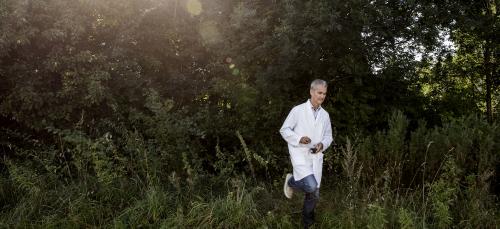New enzyme research boosts biofuel

You are confronted with a red warning sign and a reminder that access is strictly forbidden to outsiders, when you step onto the first floor of the new white laboratory building at Roskilde University.
On the other side of this sign and a glass door, Professor of Chemistry Peter Westh is currently developing ultra-efficient enzymes to ensure that in the future we can pour plant residue into our fuel tanks. The researchers' experiments are strictly controlled and must not be spoiled or disturbed by curious passers-by.
In July, the researchers' preliminary results secured them new funding from Novozymes and Innovation Fund Denmark for a new research project with a total budget of DKK 27 million. Now the work is continuing in the laboratory that has already developed several improved enzymes that have been patented worldwide.
Difficult to break down plant residues
Sustainable alternatives to fossil fuels are essential if we want to reduce the increasing levels of greenhouse gases in the atmosphere.
At Roskilde University, researchers are working diligently to make it easier to break down plant residues and quickly and inexpensively convert them into second-generation bio-ethanol, so that in future our cars will run on plant residue.
One of the challenges of making second-generation bio-ethanol profitable is that plant residues are very difficult to break down, for example because a stalk’s purpose is to be difficult to break down in nature so that it can protect the plant as well as possible. This means that it is slow, and therefore more expensive, to produce second-generation bioethanol compared with first generation bioethanol using edible crops for production.
Effective enzymes on industry’s terms
Researchers at RUC have based their endeavours on the enzymes that already exist in nature and which can withstand high temperatures, because in industry, it is most advantageous to work with at high temperatures.
n the laboratory, the researchers try to get the enzymes to work faster when they are heated up, i.e. to convert the cellulose in the plant residue into glucose, which can later be converted into ethanol. The primary goal for the scientists is to map where in the decomposition process, the enzymes find it difficult to work effectively.
"You can compare it with a shopping trip to the supermarket. It consists of various steps, where you first take a shopping basket, then you find the products, place them on the conveyor belt at the checkout etc. If it is the task of finding the products that take the longest time, then there is no point focusing on making the queue shorter", explains Peter Westh, head of the research project.
Important contribution to the bio-economy
Peter Westh’s research is an important contribution to the bio-economy, which is about the transition to a sustainable society. The EU Commission estimates that the EU's bio-economy sector is worth EUR 2 billion in revenue annually. As we reduce the consumption of fossil fuels, the demand for biomass is expected to increase significantly. The challenge is to make it profitable, so that more full-scale bio-refineries can be built around the world, of which there are only 7 at present. In fact, it was originally planned that a brand new and enormous bio-refinery in Maabjerg near Holstebro would begin producing green electricity, heat, bio-gas and second generation bioethanol from 2020, based on residue products from local agriculture. But failure to secure loan guarantees now seems to have stopped the project, at least for now.
In fact, cooperation with industry plays a vital role in RUC's research project:
"Some researchers regard it as a compromise to have to cooperate with industry, because they are afraid of having to compromise on their professionalism. But for me it has actually boosted my professionalism. It’s also very exciting that there is a direct buyer of the knowledge we produce and to work in a field where so many stakeholders are interested in what we do", says Peter Westh.
In addition to Roskilde University, Novozymes is part of the project, which will run for a period of three and a half years.
Facts:
The difference between first- and second-generation bio-ethanol
Ethanol is a liquid that is added to fuel to make it more environmentally friendly.
First-generation bio-ethanol is produced from starch and raw materials containing sugar, such as cereals like wheat, corn, sugar cane and sugar beet.
Second-generation bio-ethanol is made from raw materials containing dry matter, such as straw, wood and organic waste from agriculture and industry. The advantage is that it uses waste material and by-products that are not potential food.
Approximately 100 litres of fuel can be produced from a bale of straw, enough to allow a Fiat to drive from Denmark all the way home to Italy.
How enzymes work
Cellulose, which is the dominant structural molecule in plant residue, is very difficult to break down. This is also why stalks and straw cannot be used for human food, it is simply too difficult for the human body to digest. But there are various enzymes from micro-organisms that can break down cellulose into soluble sugars, which can then be further converted by fermentation into second-generation bioethanol.